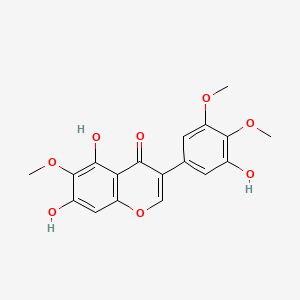irigenin



| Name | Irigenin | ||
| PubChem CID | 5464170 | ||
| Molecular Weight | 360.3g/mol | ||
| Synonyms |
irigenin |
||
| Formula | C₁₈H₁₆O₈ | ||
| SMILES | COC1=CC(=CC(=C1OC)O)C2=COC3=C(C2=O)C(=C(C(=C3)O)OC)O | ||
| InChI | 1S/C18H16O8/c1-23-13-5-8(4-10(19)17(13)24-2)9-7-26-12-6-11(20)18(25-3)16(22)14(12)15(9)21/h4-7,19-20,22H,1-3H3 | ||
| InChIKey | TUGWPJJTQNLKCL-UHFFFAOYSA-N | ||
| CAS Number | 548-76-5 | ||
| ChEMBL ID | CHEMBL487013 | ||
| ChEBI ID | CHEBI:81409 | ||
| Herb ID | HBIN030301 | ||
| KEGG ID | C17957 | ||
| Structure | 
|
Download
2D
MOL
3D
MOL
|
|
| Chineses Pinyin | SheGan | ||
| Use Part | Rhizome | ||
| Flavor | Bitter | ||
| Meridian Tropism | Lung | ||
| Species |
>Kingdom: Viridiplantae
-->Phylum: Streptophyta
-->Class: Equisetopsida
-->Order: Asparagales
-->Family: Iridaceae
-->Genus: Iris
-->Species: Iris domestica
|
||
| Pair Name | Irigenin, TNF-related apoptosis inducing ligand | |||
| Partner Name | TNF-related apoptosis inducing ligand | |||
| Disease Info | [ICD-11: 2B72.Z] | Gastric cancer | Investigative | |
| Biological Phenomena | Induction-->Apoptosis | |||
| Gene Regulation | Up-regulation | Cleavage | CASP8 | hsa841 |
| Up-regulation | Cleavage | CASP9 | hsa842 | |
| Up-regulation | Cleavage | CASP3 | hsa836 | |
| Up-regulation | Cleavage | PARP1 | hsa142 | |
| Up-regulation | Expression | FADD | hsa8772 | |
| Up-regulation | Expression | TNFRSF10B | hsa8795 | |
| Up-regulation | Expression | BAX | hsa581 | |
| Down-regulation | Expression | CFLAR | hsa8837 | |
| Down-regulation | Expression | BCL2 | hsa596 | |
| In Vitro Model | NCI-N87 | Gastric tubular adenocarcinoma | Homo sapiens (Human) | CVCL_1603 |
| SGC-7901 | Human papillomavirus-related cervical adenocarcinoma | Homo sapiens (Human) | CVCL_0520 | |
| BGC-823 | Human papillomavirus-related cervical adenocarcinoma | Homo sapiens (Human) | CVCL_3360 | |
| MGC-803 | Gastric mucinous adenocarcinoma | Homo sapiens (Human) | CVCL_5334 | |
| MKN28 | Gastric tubular adenocarcinoma | Homo sapiens (Human) | CVCL_1416 | |
| Result | Our present study gave new insights into the effects of Iri on potentiating TRAIL-sensitivity, and suggested that Iri could be a potential candidate for sensitizer of TRAIL-resistant cancer cell treatment. | |||
